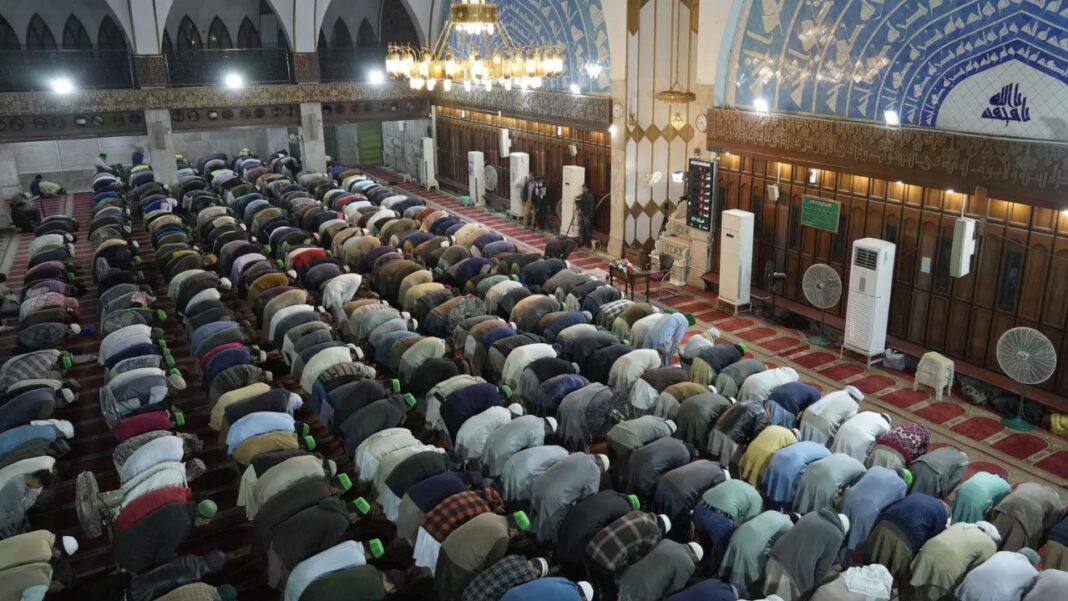On the night of March 16, some people attacked a group of foreign students as they were offering Tarawih namaz in a hostel block of Gujarat University in Ahmedabad. The incident left at least two students injured.
What is Tarawih Namaz?
Derived from the Arabic word ‘Tarawih’ (also spelt ‘Taraweeh’), meaning rest or relaxation, this prayer is performed in a relaxed manner during brief breaks between each set of four rikats or units of namaz. Tarawih is offered after the Isha namaz in the night. This is a special namaz, performed in the night from the beginning of Ramzan to the holy month’s end. For Tarawih, the imam recites verses from the Quran while followers stand behind, silently listening to the recitation. Tarawih is a congregational namaz that can be performed in a mosque, or at home and the workplace, too, if a separate space is allotted for it.
Who leads this Namaz?
A hafiz (plural huffaz) who has memorised the entire Quran leads Tarawih. The Quran consists of 114 chapters, 6,000 verses (some scholars say around 6,236, due to differences over where a verse starts or ends) and 77,439 words. Generally, some Muslim children begin hifz or memorisation of the Quran quite early. Usually, it takes between six months and one year to memorise the entire Quran. Once someone has memorised the Quran and become a hafiz, he or she starts recitations regularly, especially during the annual Tarawih prayers (a woman hafiz leads a separate congregation). Delhi-based scholar Dr Zafrul Islam Khan says a hafiz is a respected person who leads normal or Tarawih prayers. A hafiz is more respected if he is a graduate from a madrassa though most huffaz aren’t. Tarawih prayers provide huffaz with the opportunity to recite the holy verses publicly, which also works to sharpen their recall. Interestingly, at most Tarawih prayers, there’s at least one extra hafiz on standby to give luqma or help the imam if he or she forgets or skips any part during the recitation.
What makes up Tarawih?
There are 20 rikats divided into five sets of four rikats each in this special namaz. Ideally, the imam (hafiz) recites the chapters in such a way that the entire Quran is covered during Ramzan, that is, from the evening the new moon is sighted to a day before it is observed again. There is no Tarawih prayer on the night the new moon for Eid is sighted. Dr Khan says that during the Prophet’s time and, thereafter, under the first Caliph Abu Bakar and during the early period of second Caliph Umar’s rule, Tarawih used to be offered individually at the mosque or home. It was Caliph Umar who ordered that it should be offered in a congregation and that’s how it is now done across the world.
Can it be done in 10-12 days?
Some scholars say finishing something in 10 or 12 days when it should be done over a month is a departure from the norm while others argue that the rule should not be harsh. “This is an innovation (to finish Tarawih in 10 or 12 days) and, in fact, a dishonour to the Quran. The prayer leader recites the verses so fast that it is difficult to follow it. The normal practice is to complete it over the full month of Ramzan.The Quran should be recited slowly so that it is understood and followed,” says Dr Khan.
Expand
Is Tarawih compulsory?
Unlike the usual five-time namaz, Tarawih is not mandatory for Muslims. It is one of the sunnats or traditions of Prophet Muhammad and has huge significance. According to a hadith (Prophet’s sayings), “Whoever stands (in the voluntary night prayer) of Ramzan out of faith and in the hope of rewards, his previous sins will be forgiven.” Therefore, most Muslims offer Tarawih in the holy month even though it’s not mandatory, unlike the five pillars of Islam (daily namaz, kalima or declaration that God is one and Muhammad is His Prophet, roza or fasting in Ramzan, zakat or 2.5% of annual savings for charity, and Haj).




